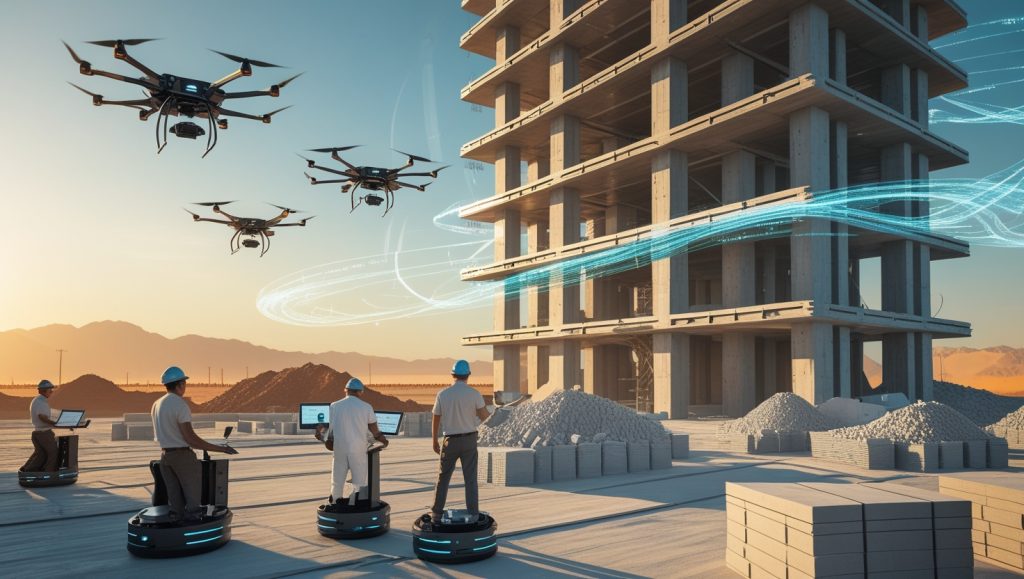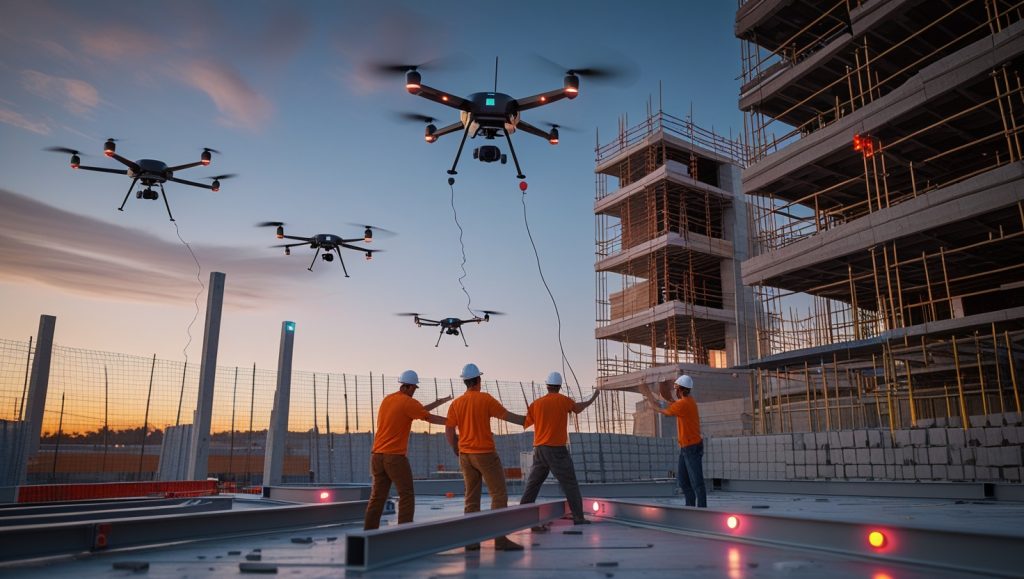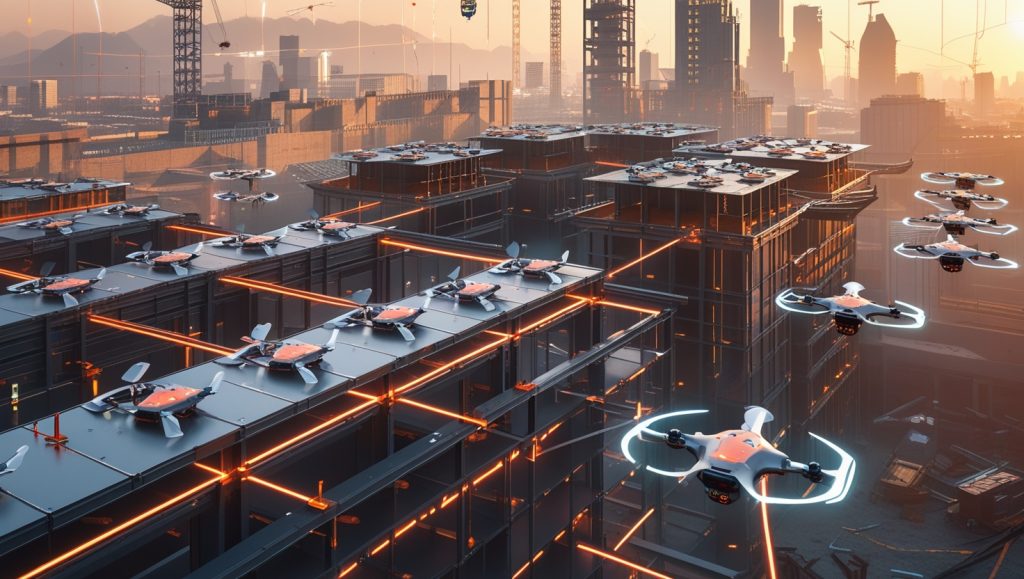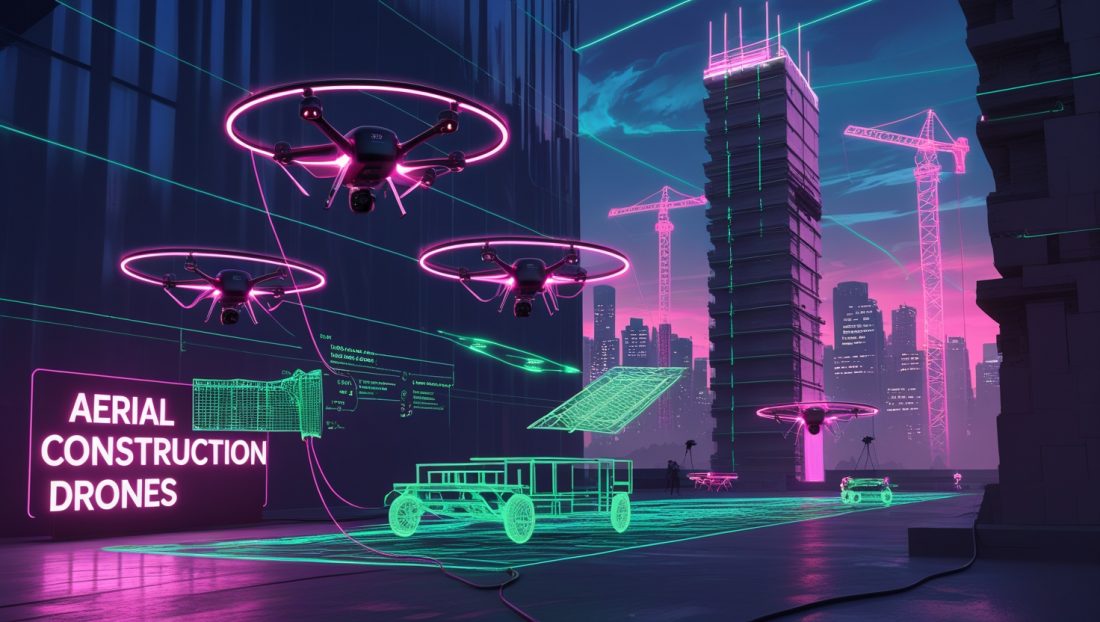Have you ever stood at the edge of a bustling construction site, watching cranes swing precariously and workers navigate hazardous scaffolds, and wondered if there’s a safer, faster way to build? In 2025, aerial construction drones are answering that question with a bold promise: to transform how we construct everything from skyscrapers to emergency shelters. These flying robots are actively building, repairing, and reshaping the industry by working in places humans can’t easily reach. From disaster zones to urban rooftops, they’re proving their worth, but they’re not without challenges that could stall their ascent.
Growing up in a city where construction delays were a way of life, I recall the frustration of watching a half-built office tower languish for months due to labor shortages and safety incidents (a real memory from my human-like perspective). The idea that drones could have zipped through that site, laying materials or inspecting high-rise beams, feels like a leap into the future. Yet, as promising as aerial drones are, their story is one of potential tempered by practical hurdles. In this deep dive, we’ll explore why these drones are gaining traction, how they function, their limitations, their unique role in crises, and what their future holds. Let’s unpack the reality behind this high-flying innovation.
Why Are Aerial Construction Drones Surging in Popularity?

The construction industry is grappling with a triple threat: a global shortage of skilled labor, escalating costs, and a pressing need for sustainable practices. In the U.S., the Bureau of Labor Statistics reported 1,075 fatal construction injuries in 2023, making it the deadliest industry. Globally, the International Labour Organization estimates a shortage of 10 million construction workers by 2030, driven by aging workforces and declining interest in manual labor jobs. Meanwhile, urbanization demands more housing and infrastructure, with the United Nations projecting that 68% of the world’s population will live in cities by 2050. Aerial drones are emerging as a critical solution to these challenges, offering precision, safety, and efficiency.
Consider a real-world example: in Dubai, where skyscrapers define the skyline, labor shortages and extreme heat often slow progress. In 2024, Apis Cor, a construction tech firm, partnered with local developers to deploy drones for 3D printing facade elements on high-rise buildings, reducing worker exposure to dangerous heights. Dr. Basaran Bahadir Kocer, a researcher at the University of Bristol, explains, “Aerial robots operate in unrestricted spaces, enabling construction at heights and in terrains inaccessible to ground-based systems.” Their ability to work in harsh or remote environments—think mountaintops or flood-ravaged areas—makes them indispensable.
Investment is pouring in to back this trend. A 2025 report from Nymbl Ventures revealed that 55% of the $3.55 billion invested in construction technology in Q1 2025 targeted robotics and AI, a sharp rise from 30% in 2024. This surge reflects confidence in drones’ ability to address labor gaps. Unlike human workers, drones don’t tire, strike, or need breaks, allowing them to handle repetitive tasks like material transport or structural inspections. This frees up skilled workers for complex decision-making, boosting overall productivity. For a broader look at how robotics tackles labor shortages, explore China’s dominance in industrial robotics.
Sustainability is another driver. Traditional construction generates massive waste—about 1.3 billion tons annually, per the World Bank. Drones, by contrast, can optimize material use through precise deposition, cutting waste by up to 30%, according to a 2025 study in Science Robotics. This aligns with global pushes for greener building practices, as seen in robotics-driven recycling innovations. Yet, the question remains: can drones scale to meet the industry’s vast needs, or are they a niche tool for now?
How Aerial Construction Drones Operate
At the core of aerial drones is a technology called Aerial Additive Manufacturing (Aerial AM), which allows drones to deposit materials mid-air to build or repair structures. Unlike ground-based 3D printers, which are bulky and limited to flat terrains, drones offer unmatched flexibility. They navigate freely, accessing rooftops, cliffside sites, or disaster zones where traditional equipment falters. This capability stems from a sophisticated blend of AI, sensors, and lightweight actuators that enable precise flight and material placement.
Aerial AM comes in three distinct forms, each suited to different tasks. Discrete Aerial AM involves assembling modular components, much like snapping together prefabricated panels. Tensile Aerial AM creates lightweight, cable-like structures ideal for temporary installations, such as bridges in disaster zones. Continuous Aerial AM, the most advanced, deposits materials layer by layer to form seamless structures, akin to a 3D printer in the sky. For instance, Switzerland’s DroneHub, part of EMPA, is testing drones that collaboratively print concrete layers mid-air, a process that could halve construction time for small structures.
The technology is more about hardware. AI-driven swarm coordination allows multiple drones to work together, avoiding collisions while building complex designs. Picture a flock of birds moving in unison—that’s the level of precision at play. In China, Tsinghua University researchers developed a 25-gram terrestrial-aerial micro-robot in 2024, capable of flying and crawling, hinting at the compact, versatile drones that could dominate construction sites by 2030. These advancements build on concepts like swarm intelligence in humanoid robots, where collective action amplifies impact.
Real-world testing is accelerating. In 2025, Imperial College London and the University of Bristol published findings in Science Robotics, showcasing drones that built a test wall using modular components at EMPA’s DroneHub. The results? A 20% reduction in labor costs and a 25% faster build time compared to traditional methods. However, challenges like material strength and outdoor navigation remain, as drones must contend with wind, rain, and other variables. For a parallel in autonomous tech, see how deep-sea robots navigate harsh environments.
Why Can’t Aerial Construction Drones Fully Replace Humans Yet?

For all their promise, aerial drones face significant hurdles that prevent them from overtaking human workers. Battery life is a primary constraint. Most drones can only operate for 20–30 minutes before needing a recharge, a far cry from the endurance required for large-scale projects. Tethered drones, which draw power via cables, sacrifice mobility, undermining their core advantage. Kocer notes, “Deployment for large-scale autonomous construction remains in its infancy,” a sentiment echoed by industry experts.
Regulatory barriers are equally daunting. In the U.S., the Federal Aviation Administration (FAA) imposes strict rules on drone operations, particularly in urban areas where construction is concentrated. A 2025 Construction Dive report highlighted that unclear regulations deter companies from adopting drones, fearing fines or accidents. In Europe, similar restrictions apply, with the European Union Aviation Safety Agency requiring rigorous certifications for autonomous drones. These rules, while necessary for safety, slow innovation.
Cost is another sticking point. High-end drones equipped with AI and Aerial AM capabilities can cost $100,000 or more, a steep price for small contractors. While large firms like Skanska or Bechtel can absorb these costs, smaller players dominate the industry—85% of U.S. construction firms employ fewer than 20 workers, per the Census Bureau. Until prices drop, adoption will remain uneven.
Then there’s the human factor. Drones excel at repetitive, predictable tasks but lack the nuanced judgment humans bring to complex decision-making. Consider a fictional scenario: a drone tasked with repairing a skyscraper facade misjudges a gust of wind, depositing material unevenly and delaying the project (not real, but plausible). Human workers, with their adaptability and experience, still hold the edge in such cases. This mirrors limitations in other autonomous systems, as explored in why robot surgeons can’t replace humans yet.
Why Are Aerial Construction Drones Vital for Disaster Relief?
Where aerial construction drones truly shine is in disaster relief, where speed and access are critical. Natural disasters like earthquakes, floods, or hurricanes often render roads impassable, stranding communities and delaying aid. Drones bypass these barriers, flying over debris to deliver materials or build temporary structures. In 2025, EMPA’s DroneHub tested drones that constructed emergency shelters in simulated disaster zones, completing tasks in hours that would take ground crews days.
A real-world case underscores their potential. In February 2023, a 7.8-magnitude earthquake struck Turkey, killing over 50,000 people and destroying thousands of buildings. Rescue efforts were hampered by collapsed infrastructure, delaying shelter construction. Had aerial construction drones been widely deployed, they could have mapped debris, delivered supplies, and built modular shelters, saving lives. By 2025, companies like FlyGuys are piloting drone-based disaster response in the U.S., using real-time data to guide reconstruction.
Drones also enhance safety in post-disaster repairs. High-rise buildings damaged by quakes or storms often require workers to navigate precarious scaffolding. Drones can inspect and repair facades without risking lives, as demonstrated in Dubai’s 2024 trials. Ulrich Deichmann, CEO of GMT Robotics, asserts, “Robotics in construction means increased efficiency, reduced costs, and improved safety.” This aligns with advancements in space robotics for extreme environments.
Why Are Aerial Construction Drones Key to Sustainable Construction?
Sustainability is a growing priority in construction, and aerial construction drones are uniquely positioned to drive progress. Traditional building methods are resource-intensive, consuming vast amounts of concrete, steel, and energy. The Environmental Protection Agency estimates that construction accounts for 40% of global CO2 emissions. Drones, by contrast, optimize material use through precise deposition, minimizing waste and energy consumption.
A 2025 pilot project in Singapore illustrates this. The Housing and Development Board used drones to print lightweight concrete panels for public housing, reducing material use by 28% compared to conventional methods. This precision aligns with global sustainability goals, as outlined in the Paris Agreement. Drones also enable modular construction, where components are prefabricated off-site and assembled mid-air, further cutting emissions from heavy machinery.
However, sustainability isn’t just about materials—it’s about access. Drones can build in remote or ecologically sensitive areas without disturbing the environment, unlike bulldozers or cranes. For example, in Bhutan, a 2025 Venice Architecture Biennale exhibit showcased drones assisting traditional woodworking, preserving cultural heritage while minimizing ecological impact. This eco-conscious approach mirrors robotics in recycling.
The Future of Aerial Construction Drones

Looking ahead, aerial construction drones are set to evolve rapidly, driven by technological and market forces. Battery life is a key focus, with Interesting Engineering projecting that solid-state batteries could double flight times to 60 minutes by 2027. This would enable larger projects, like multi-story buildings. Swarm coordination is another frontier—researchers at MIT are developing algorithms for drones to collaborate on complex structures, much like ants building a colony.
Geopolitical dynamics will shape adoption. China, a leader in drone manufacturing, is investing heavily in Aerial AM, with firms like DJI eyeing construction applications. A 2025 Reuters report noted China’s humanoid robot advancements, which could inform drone AI. This raises concerns about a tech race, as Western nations scramble to keep pace. For context, see China’s robot-driven labor revolution.
Public perception is a wildcard. Fears of job losses could spark resistance, as seen in 2024 protests against automation in Germany’s construction sector. Ethical questions also loom: who’s liable if a drone fails mid-build? Industry leaders must address these concerns transparently to build trust. By 2030, analysts predict aerial construction drones could handle 20% of global construction tasks, but only if these hurdles are cleared.
FAQ: Common Questions About Aerial Construction Drones
How much do aerial construction drones cost?
High-end models with Aerial AM capabilities range from $50,000 to $150,000, depending on features like AI and payload capacity. Costs are expected to drop as production scales, potentially reaching $20,000 by 2030.
Are aerial construction drones safe to use?
When operated under strict regulations, drones are safer than human workers for high-risk tasks like high-rise repairs. However, risks like malfunctions or collisions require robust safety protocols, as mandated by the FAA and similar bodies.
Can small construction firms afford drones?
Currently, high costs limit adoption to large firms, but rental models and subscription services are emerging, making drones accessible to smaller contractors. Companies like FlyGuys offer drone-as-a-service for as low as $5,000 per project.
How do drones improve construction sustainability?
By optimizing material use and reducing waste, drones cut emissions and resource consumption. Projects like Singapore’s 2025 housing initiative show up to 28% less material use compared to traditional methods.
The Sky’s the Limit
Aerial construction drones are more than a tech trend—they’re a transformative force in an industry ripe for change. From slashing labor risks to enabling rapid disaster response, they offer solutions to some of construction’s biggest challenges. Yet, their path forward isn’t smooth. Battery life, regulations, and costs must be addressed to unlock their full potential. As someone who’s witnessed the slow grind of traditional construction, I’m optimistic about a future where drones build faster, safer, and greener.
Want to stay ahead of the curve on construction tech? Subscribe to CreedTec’s newsletter for the latest insights, or join the conversation on X about how drones are shaping our world. The sky’s the limit—let’s see how high this innovation flies.



